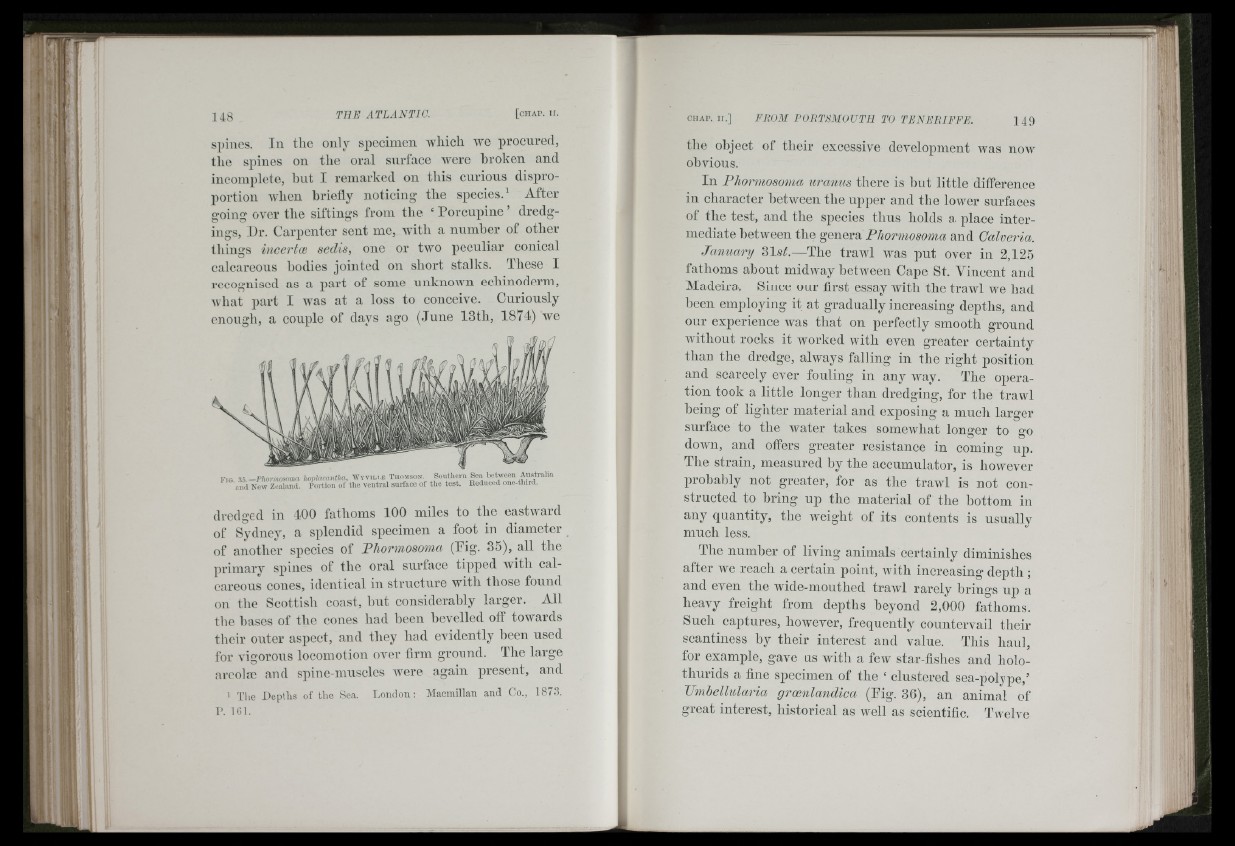
rspines.
In the only specimen whicli we procured,
the spines on the oral surface were broken and
incomplete, but I remarked on this curious disproportion
Avlien briefly noticing the species.^ After
going over tbe siftings from the ‘ Porcupine ’ dredgings,
Dr. Carpenter sent me, with a number of other
things incertw sedis, one or two peculiar conical
calcareous bodies jointed on short stalks. These I
recognised as a part of some unknown echinoderm,
Avhat part I was at a loss to conceive. Curiously
enough, a couple of days ago (June 13th, 1874) we
F ig r o -P h o rm o s o m a hoplacantiia, W v v i l i .e T h o m s o n . Southern Sea between Australia
raid New Zealand. Tovtion of the v entral surface of th e te st. Reduced one-tlnrd.
dredged in 400 fathoms 100 miles to the eastward
of Sydney, a splendid specimen a foot in diameter
of another species of Bliormosoma (Tig. 35), all the
primary spines of the oral surface tipped Avith calcareous
cones, identical in structure Avith those found
on the Scottish coast, hut considerably larger. All
the bases of the cones had heen bevelled off toAvards
their outer aspect, and they had evidently been used
for vigorous locomotion OA'cr firm ground. The large
areola) and spine-mnscles Avere again present, and
’ The Deptlis of the Sea. London: Macmillan and Co., 187-3.
I>. ICl.
CHAP. I I . ] F R O M P O R T S M O U T H T O T E N E R I F F E . 1 4 9
the object of tbeir excessive development was noAv
obvious.
In Phormosoma uranus there is but little difference
in character between the upper and the lower surfaces
of tlie test, and the species thus holds a place intermediate
between the genera Phormosom.a and Calveria.
January Wist.—The traAvl was put over in 2,125
fathoms ahout midAvay hetAveen Cape St. Vincent and
Madeira. Since our first essay Avith the trawl we had
been employing it at gradually increasing depths, and
our experience AA^as that on perfectly smooth ground
Avithout rocks it Avorked with even greater certainty
than the dredge, ahvays falling in the right position
and scarcely ever fouling in any Avay. The operation
took a little longer than dredging, for tbe trawl
being of ligiiter material and exposing a much larger
surface to the AAmter takes somewhat longer to go
doAA'u, and offers greater resistance in coming up.
The strain, measured by the accumulator, is however
probably not greater, for as the trawl is not constructed
to bring up the material of the bottom in
any quantity, the weight of its contents is usually
much less.
The number of living animals certainly diminishes
after Ave reach a certain point, Avith increasing depth ;
and even the Avide-mouthed trawl rarely brings up a
heavy freight from depths heyond 2,000 fathoms.
Such captures, however, frequently countervail their
scantiness hy their interest and value. This haul,
for example, gave ns with a fcAv star-fishes and holo-
thurids a fine specimen of the ‘ clustered sea-polype,’
JJmhellularia groenlandica (Tig. 36), an animal of
great interest, historical as Avell as scientific. Twelve
Tl'
iiit) :I
- It ;
k l : .
!'
• i. '• ■’ v:i
Sl
J :